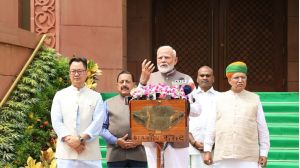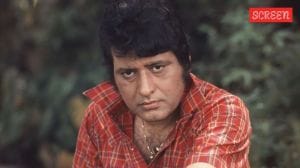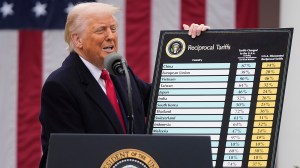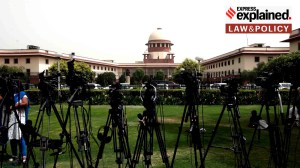UPSC Key: Fram2 Polar Mission, Judicial Conscience and BIMSTEC
Why India-Chile Bilateral Relations is relevant to the UPSC exam? What is the significance of topics such as Mahabodhi temple, One Sun One World One Grid and Polar Orbits on both the preliminary and main exams? You can learn more by reading the Indian Express UPSC Key for April 2, 2025.
 UPSC Key April 2025: Here's what you should be reading from the April 2, 2025 edition of The Indian Express
UPSC Key April 2025: Here's what you should be reading from the April 2, 2025 edition of The Indian Express Important topics and their relevance in UPSC CSE exam for April 2, 2025. If you missed the April 1, 2025 UPSC CSE exam key from the Indian Express, read it here
THE WORLD
SPACEX LAUNCHES FRAM2 POLAR-ORBITING MISSION
Syllabus:
Preliminary Examination: Current events of national and international importance.
Main Examination: General Studies III:Awareness in the fields of IT, Space, Computers, robotics, nano-technology, biotechnology and issues relating to intellectual property rights.
What’s the ongoing story: SpaceX’s Falcon 9 rocket gets launched with four commercial astronauts on the Fram2 polar mission at the Kennedy Space Centre in Cape Canaveral, Florida, on Monday. The private astronauts led by a crypto entrepreneur will orbit Earth from pole to pole, a novel trajectory in which no humans have travelled before.
Key Points to Ponder:
• What is Fram2 mission?
• Can you explain what SpaceX’s private Fram2 mission accomplished that made history?
• What is the polar orbit of the Earth?
• Why are satellites placed in Polar Orbits?
• What is the difference between geostationary and polar orbit?
• What are the three types of orbits?
• Do you know about Low Earth Orbit (LEO), Medium Earth Orbit (MEO), and Geostationary Earth Orbit (GEO) (also known as High Earth Orbit)?
• India is developing its own human spaceflight program under the Gaganyaan mission. Compare and contrast India’s approach with that of private players like SpaceX in the field of human space exploration.
Key Takeaways:
• The mission, SpaceX’s sixth private astronaut flight, is the company’s latest novel effort that expands its dominance in the global human spaceflight arena. It comes as Musk’s power as SpaceX CEO.
• Fram2 is the 16th crewed mission overall using the reusable Crew Dragon, a gumdrop-shaped spacecraft that SpaceX developed with NASA funding to provide the U.S. space agency a ride for its astronauts to and from the International Space Station.
• Fram2 will be a multi-day space mission in which the Dragon spacecraft and its crew will explore Earth from polar orbit, flying over the polar regions. The astronauts will conduct 22 research studies focused on understanding human health in space. Their experiments include taking the first X-ray in space to study muscle and skeletal mass and growing mushrooms in microgravity.
• The objective of the spaceflight is to study the polar regions of Earth from the Dragon capsule which will be orbiting at 425-450 kilometres above the surface. Specifically, the astronauts will be observing unusual light emissions similar to auroras i.e. the Northern lights (Aurora borealis) and Southern lights (Aurora australis).
• The mission hopes to provide additional insights for SpaceX on how being in space affects the human body by “capturing the first human x-ray images in space, Just-in-Time training tools, and studying the effects of spaceflight on behavioral health, all of which will help in the development of tools needed to prepare humanity for future long-duration spaceflight.”
Do You Know:
According to NASA and ESA websites—
• An orbit is the curved path that an object in space (like a star, planet, moon, asteroid or spacecraft) follows around another object due to gravity.
• An object in motion will stay in motion unless something pushes or pulls on it. This statement is called Newton’s first law of motion. Without gravity, an Earth-orbiting satellite would go off into space along a straight line. With gravity, it is pulled back toward Earth. A constant tug-of-war takes place between the satellite’s tendency to move in a straight line, or momentum, and the tug of gravity pulling the satellite back.
• The International Space Station is in low Earth orbit, or LEO. LEO is the first 100 to 200 miles of space. LEO is the easiest orbit to get to and stay in. One complete orbit in LEO takes about 90 minutes.
• Satellites that stay above a location on Earth are in geosynchronous Earth orbit, or GEO. These satellites orbit about 23,000 miles above the equator and complete one revolution around Earth precisely every 24 hours. Geosynchronous orbits are also called geostationary.
• Polar orbits are a type of low Earth orbit, typically between 200 to 1000 km in altitude. Satellites in polar orbits usually travel around Earth from, roughly, one pole to the other, rather than from west to east. They do not need to pass exactly over the North and South Poles; a deviation of 10 degrees is still classed as a polar orbit.
• Polar orbits are particularly useful for global Earth coverage, as satellites orbiting ‘up’ and ‘down’ Earth’s surface can see every inch of the planet over time as it also rotates below.
Other Important Articles Covering the same topic:
📍SpaceX’s next big mission to explore polar orbit, a first for spaceflight
Previous year UPSC Prelims Question Covering similar theme:
1. An artificial satellite orbiting around the Earth does not fall down. This is so because the attraction of Earth (2011)
(a) does not exist at such distance
(b) is neutralized by the attraction of the moon
(c) provides the necessary speed for its steady motion
(d) provides the necessary acceleration for its motion
2. Satellites used for telecommunication relay are kept in a geostationary orbit. A satellite is said to be in such as orbit when: (2011)
1. The orbit is geosynchronous.
2. The orbit is circular.
3. The orbit lies in the plane of the earth’s equator.
4. The orbit is at an altitude of 22,236 km.
Select the correct answer using the codes given below:
(a) 1, 2 and 3 only
(b) 1, 3 and 4 only
(c) 2 and 4 only
(d) 1, 2, 3 and 4
FRONT PAGE
Syllabus:
Preliminary Examination: Indian Polity and Governance – Constitution, Political System, Panchayati Raj, Public Policy, Rights Issues
Main Examination:
• General Studies II: Functioning of the Executive and the Judiciary
• General Studies II: Government policies and interventions for development in various sectors and issues arising out of their design and implementation
• General Studies IV: Public/Civil service values and Ethics in Public administration
What’s the ongoing story: CRITICISING THE demolition of some houses by local authorities in Uttar Pradesh’s Prayagraj in 2021 as “inhuman and illegal”, the Supreme Court on Tuesday said the “high-handed” manner in which this was done “shocks our conscience”. It directed the Prayagraj Development Authority to pay Rs 10 lakh each to those affected within six weeks.
Key Points to Ponder:
• What is conscience?
• Why is conscience important?
• Demolition drive and judicial conscience—connect the dots
• What exactly Supreme Court said about demolitions?
• Supreme Court’s intervention in the Prayagraj demolitions case—Discuss
• The Supreme Court of India has held that forced demolitions without due process violates which legal principles? (Hint: have you heard of Principle of Natural Justice?)
• How does the Supreme Court’s recent directives enforce the principles of justice and due process of law?
• What is the property right in India?
• What is the principle of ‘Eminent Domain’? how this principle is applied in India, keeping in view the Supreme Court’s stance on illegal demolitions.
Key Takeaways:
• The bench of Justices A S Oka and Ujjal Bhuyan was hearing an appeal against the Allahabad High Court’s decision, on March 8, 2021, to dismiss a clutch of petitions against the demolitions carried out the previous day. The petitioners included a professor, a lawyer and three others.
• Saying that the appellants were not given a “reasonable opportunity” to explain their position, the SC said: “These cases shock our conscience. Residential premises of the appellants have been high-handedly demolished… Carrying out demolition in such a manner shows insensitivity on the part of the statutory development authority… The authorities, and especially the development authority, must remember that the right to shelter is also an integral part of Article 21 of the Constitution of India.”
• The HC had noted that the matter concerned a Nazul plot (government land for public purpose) leased in 1906. It noted that after the lease expired in 1996, applications for freehold conversion were rejected in 2015 and 2019, and there was nothing on record to show that the constructions were carried out with the sanction of the municipal/ local/ development authority.
• While the SC did not comment on the land rights, it criticised the manner in which the demolition notice was served to the occupants. The local authorities had affixed the notice on the premises, saying the occupants could not be tracked.
• According to the petitioners, they received a notice dated March 1, 2021, which said that as per an earlier notice dated January 8, 2021, sent to them, they were required to demolish the unauthorised structures before January 27, 2021, and the demolitions would now be carried out at their expense. The petitioners said the January 8, 2021, notice was not served on them.
Do You Know:
The guidelines laid down by the SC place regarding the demolitions are:
• PROVIDING NOTICE: The SC said a minimum of 15 days prior notice must be given for a person to respond to before demolition is carried out, starting from the date that the owner or the occupier receives the notice.
• HEARING & FINAL ORDER: After conducting a hearing where the minutes are properly recorded, the SC said the final order must mandatorily contain certain information. This includes the arguments made by the owner or the occupier, why the authority (such as the local municipal corporation) believes the case cannot be settled, and whether the entire construction or only a part is to be demolished.
• THE AFTERMATH: If the authority passes a final order for demolition, and after the property owner or the occupier receives the order, the SC said, “the order will not be implemented for a period of 15 days”. This allows the owner or the occupier to either remove the construction or challenge the final order in court and seek a stay order.
• At the end of this second 15-day period, if the final demolition order has not been stayed and the construction has not been removed, demolition can be carried out.
• The SC relied on several fundamental constitutional and legal principles that are violated when the illegal demolition of an accused person’s property takes place.
• SEPARATION OF POWERS: The verdict stresses that the judiciary is entrusted with “adjudicatory” (decision-making) powers to decide if an accused person is guilty, and whether any of the organs of the state have “transgressed” their limits.
• PUBLIC TRUST & TRANSPARENCY: The SC said public officials must be held accountable for both their actions and inactions. Officials who “take the law in their hands” and pass demolition orders on the ground that the owner or occupier of the property is an accused “should be made accountable for such high-handed actions,” according to the court.
• RIGHT TO SHELTER: The SC noted that the accused is not the only one who lives or owns such properties. It highlighted that the right to life with dignity under Article 21 of the Constitution includes the right to shelter. Depriving this right of the other innocent people living in the same house as the accused would be “wholly unconstitutional”, according to the SC.
Other Important Articles Covering the same topic:
📍UPSC Ethics Simplified | Conscience and Ethical Decision Making: The Concept
📍What Supreme Court said about ‘bulldozer justice’ in its verdict
Previous year UPSC Prelims Question Covering similar theme:
3. What is the position of the Right to Property in India? (2021)
(a) Legal right available to citizens only
(b) Legal right available to any person
(c) Fundamental Right available to citizens only
(d) Neither Fundamental Right nor legal right
4. In essence, what does ‘Due Process of Law’ mean? (2023)
(a) The principle of natural justice
(b) The procedure established by law
(c) Fair application of law
(d) Equality before law
Previous year UPSC mains Question Covering similar theme:
📍Is conscience a more reliable guide when compared to laws, rules and regulations in the context of ethical decision-making? Discuss. (2023)
📍In case of crisis of conscience does emotional intelligence help to overcome the same without compromising the ethical or moral stand that you are likely to follow? Critically examine. (2022)
India finalises US trade deal terms, Trump says Delhi ‘dropping’ tariffs
Syllabus:
Preliminary Examination: Current events of national and international importance.
Main Examination: General Studies II: Bilateral, regional and global groupings and agreements involving India and/or affecting India’s interests.
What’s the ongoing story: A DAY BEFORE the US reciprocal tariffs kick in on April 2, India has agreed to the Terms of Reference for the Bilateral Trade Agreement with the US following an intervention from the Prime Minister’s Office (PMO).
Key Points to Ponder:
• ‘India agreed to the Terms of Reference for the Bilateral Trade Agreement with the US’—What exactly India agreed for?
• What should a Terms of Reference include?
• Why India-US trade relations is significant?
• What are the key areas of contention in India-US trade negotiations?
• How will the recent bilateral trade agreement with the US impact India’s domestic industries, particularly in sectors like pharmaceuticals, agriculture, and technology?
• Compare and contrast India’s trade strategy with the US to its trade agreements with other major economies such as the European Union and ASEAN.
Key Takeaways:
• The ToR outlines the framework of the BTA and typically requires clearance from the highest political office before negotiations begin. “The PMO is keen on a swift finalisation of the deal,” a senior government official told The Indian Express.
• Finalisation of the ToR was still pending on Saturday when US negotiators left India after four days of talks. Both sides are now ready for formal negotiations where India is expected to lower tariffs on American goods in exchange for US concessions, the government official said.
• US President Donald Trump said Tuesday that India was willing to cut tariffs, hinting at possible relief for India from sweeping US tariffs. “I heard that India is going to be dropping its tariffs substantially. A lot of countries are going to drop their tariffs,” Trump said during a White House press briefing.
Do You Know:
• Putting pressure on India and other trading partners, the United States Trade Representative (USTR) also raised a range of concerns in its report ‘Foreign Trade Barriers’ covering 29 major partner countries. As far as India is concerned, the concerns range from Internet shutdowns and dairy feed rules to restrictions on imports of agriculture and GM foods.
• Ajay Srivastava, former Indian trade officer and head of the think tank Global Trade Research Initiative (GTRI), warned that while US is pressuring India to amend its trade policies to benefit American interests, New Delhi must assess each demand through the lens of its own national priorities, development goals, and cultural values.
• The USTR report criticised various Indian trade barriers, from “localised internet shutdowns that disrupt commercial operations” to regulations requiring that “dairy products intended for food must be derived from animals that have not consumed feed containing blood meal.”
• The report reiterated a long-standing American concern over India’s agricultural support programmes, which, according to the US, distort markets. However, Indian officials have argued that US subsidies for farmers are much higher compared to what India provides.
• The US also criticised India’s restrictions on pulse imports, calling them opaque and unpredictable. It raised concerns over import controls on boric acid, claiming that approval processes favour domestic manufacturers.
Other Important Articles Covering the same topic:
📍‘India will be dropping tariffs very substantially’: Trump on the eve of ‘liberation day’
Previous year UPSC Prelims Question Covering similar theme:
5. Consider the following statements: (2023)
Statements-I: Recently, the United States of America (USA) and the European Union (EU) have launched the ‘Trade and Technology Council’.
Statement-II: The USA and the EU claim that through this they are trying to bring technological progress and physical productivity under their control.
Which one of the following is correct in respect of the above statements?
(a) Both Statement-I and Statement-II are correct and Statement-II is the correct explanation for Statement-I
(b) Both Statement-I and Statement-II are correct and Statement-II is not the correct explanation for Statement-I
(c) Statement-I is correct but Statement-II is incorrect
(d) Statement-I is incorrect but Statement-II is correct
GOVT & POLITICS
India, Chile agrees to begin talks for economic partnership pact
Syllabus:
Preliminary Examination: Current events of national and international importance.
Main Examination: General Studies II: Bilateral, regional and global groupings and agreements involving India and/or affecting India’s interests.
What’s the ongoing story: As India and Chile agreed to start negotiations for a comprehensive economic partnership agreement after a bilateral meeting with the visiting President of Chile Gabriel Boric Font, Prime Minister Narendra Modi described Chile as the “gateway to Antarctica”.
Key Points to Ponder:
• Map Work-Chile
• Why is Chile classified as Latin American?
• India-Chile Bilateral Relations—know in detail
• Chile and critical mineral resources-know in detail
• ‘Chile currently holds more than a third of the world’s lithium reserves’—how this will benefit India?
• What are the strategic implications of India-Chile cooperation?
• What are the key challenges in strengthening India-Chile trade and investment relations?
• Examine the role of regional trade blocs like the Pacific Alliance and MERCOSUR in facilitating India’s trade with Latin America.
Key Takeaways:
• “Today we have instructed our teams to begin discussions on a mutually beneficial comprehensive economic partnership agreement,” Modi said, adding that the India-Chile partnership will be strengthened in the field of critical minerals and work will be done to establish resilient supply and value chains.
• In the field of agriculture, cooperation will be done to ensure food security by combining each other’s capabilities, he said.
• Describing Chile as an important partner of India in Latin America, Modi said: “India is ready to share its positive experience with Chile in Digital Public Infrastructure, Renewable Energy, Railways, Space and other areas.”
• PM Modi said they also signed a letter of Intent as Chile is seen as the “Gateway to Antarctica”. “We welcome the agreement reached today on the Letter of Intent between the two sides to enhance cooperation in this important area,” he said. Chile is considered a gateway to Antarctica primarily due to its geographic proximity and the presence of key cities like Punta Arenas, which serve as major departure points for expeditions and scientific research trips to the continent.
• Reflecting on the ongoing and growing relationship between India and Chile, the Chilean President said, “Today, we have come to consolidate the seven decades of our relation with India which are based on the earlier visits with Chile. I have the honour of being the third president to visit India after 16 years.”
• PM Modi said that in the discussions, the two leaders identified untapped potential in the field of investment. “In today’s discussions, we identified several new initiatives to enhance cooperation in the coming decade. We welcome the growth in mutual trade and investment. We agree that there is also untapped potential for more cooperation in this,” he said.
Do You Know:
• Home to the world’s largest reserves of lithium and copper — key inputs for electric vehicle (EV) batteries — Chile plays a pivotal role in the global critical minerals supply chain.
• Chile is India’s fifth largest trading partner in South America, with bilateral trade touching $3.8 billion in 2024 from $1.5 billion in 2020, according to a note by the Ministry of External Affairs (MEA). In 2024, exports from India totalled $1.2 billion and imports from Chile amounted to $2.6 billion.
• More than half of Chile’s exports to India consist of copper ores and concentrates, unrefined copper, and copper scrap, followed by molybdenum ores and concentrates. Since lithium-ion battery manufacturing in India is still in its early stages, it does not import any lithium from Chile.
• “India’s exports to Chile had been growing steadily since 2009, with the exception of a slight decrease in 2014, when a new carbon tax on diesel vehicles in Chile adversely affected motor vehicle exports from India, but the sector saw a big recovery later on,” the MEA note said.
• “India’s trade with Chile registered a negative growth over a couple of years due to the global slowdown and the domestic social crisis and labour unrest in Chile. The trade has since picked up and shown a robust recovery,” it added.
• India and Chile’s announcement of a potential CEPA, set to facilitate freer trade in critical minerals, follows their 2016 expansion of the India-Chile Preferential Trade Agreement (PTA) from 474 to 2,829 tariff lines.
Other Important Articles Covering the same topic:
📍India, Chile eye deeper economic ties, critical minerals in focus
THE EDITORIAL PAGE
Syllabus:
Preliminary Examination: Current events of national and international importance.
Mains Examination: General Studies II: Bilateral, regional and global groupings and agreements involving India and/or affecting India’s Interest
What’s the ongoing story: C Raja Mohan writes: Delhi cannot rely solely on multilateral and bilateral approaches. It must identify areas for unilateral action to foster regional growth and connectivity
Key Points to Ponder:
• What is BIMSTEC?
• Bay of Bengal Initiative for Multi-Sectoral Technical and Economic Cooperation (BIMSTEC)-Member Countries
• Bay of Bengal Initiative for Multi-Sectoral Technical and Economic Cooperation (BIMSTEC)-Background, Current host Country 2025, Vision and Mandate
• Bay of Bengal Initiative for Multi-Sectoral Technical and Economic Cooperation (BIMSTEC) and India
• SAARC and BIMSTEC-Difference and Importance
• Growth of BIMSTEC as a regional forum and India’s role-Analyse
• Why BIMSTEC is Significant for India?
Key Takeaways:
C Raja Mohan writes:
• As Prime Minister Narendra Modi heads to the Bay of Bengal Initiative for Multi-Sectoral Technical and Economic Cooperation (BIMSTEC) forum’s summit this week, a sizeable portion of Indian diplomatic energy is focused on addressing the earthquake tragedy in Myanmar, one of its key members, which has also affected Thailand, another member. The remaining members — Bhutan, Bangladesh, India, and Sri Lanka — are from South Asia.
• While the PM directs India’s active contribution to international relief and rehabilitation efforts in Myanmar, he must also address the longer-term challenge of revitalising the BIMSTEC forum
• Any reference to BIMSTEC inevitably raises its unfortunate image as an alternative to SAARC, the stalled forum for regional cooperation in the Subcontinent. This perception arose partly because the Modi government’s push to enhance BIMSTEC activity followed immediately after the SAARC summit’s failure in 2014.
• While the Bay of Bengal constitutes a natural region with historical interconnections, the post-War evolution of the littoral has complicated efforts to restore these natural bonds. The British Raj had unified the littoral in a modern, albeit colonial, framework. It projected power into the Bay of Bengal’s hinterlands and across its waters, colonising Burma and controlling Singapore and the settlements along the Malacca Strait connecting the Bay of Bengal to the South China Sea.
• Several factors have impeded Bay of Bengal regionalism. Unlike Pakistan in SAARC, no member wields a veto in BIMSTEC. Yet, structural constraints persist. BIMSTEC has yet to achieve the level of mutual trust present in the Association of Southeast Asian Nations, where
member states set aside bilateral disputes to pursue shared goals of growth and connectivity.
Do You Know:
• According to official website of BIMSTEC, the Bay of Bengal Initiative for Multi-Sectoral Technical and Economic Cooperation (BIMSTEC) is a regional organization that was established on 06 June 1997 with the signing of the Bangkok Declaration. Initially known as BIST-EC (Bangladesh-India-Sri Lanka-Thailand Economic Cooperation), the organisation is now known as BIMSTEC and comprises seven Member States with the admission of Myanmar on 22 December 1997, and Bhutan and Nepal in February 2004. On 06 June 1997, representatives of the Governments of Bangladesh, India, Sri Lanka, and Thailand came together in Bangkok, and signed the ‘Declaration on the Establishment of the Bangladesh–India–Sri Lanka–Thailand Economic Cooperation (BIST-EC)’.
Other Important Articles Covering the same topic:
Previous year UPSC Prelims Question Covering similar theme:
📍Do you think that BIMSTEC is a parallel organisation like the SAARC? What are the similarities and dissimilarities between the two? How are Indian foreign policy objectives realized by forming this new organisation? (2022)
THE IDEAS PAGE
Syllabus:
Preliminary Examination: Economic and Social Development
Main Examination: General Studies III: Infrastructure: Energy, Ports, Roads, Airports, Railways etc.
What’s the ongoing story: Pratik Agarwal Writes: Just as India has revolutionised payments with UPI, we would build the global infrastructure for electricity clearing and settlement
Key Points to Ponder:
• India’s role in building a global and seamless energy network—Discuss
• How can India leverage its renewable energy potential for international energy cooperation?
• What is India’s One Sun One World One Grid (OSOWOG) initiative
• The concept of a global energy grid has been gaining traction—Assess the feasibility, benefits, and challenges associated with India’s One Sun One World One Grid (OSOWOG) initiative.
• How India can utilise international partnerships and policies in achieving a sustainable energy future?
• How does cross-border electricity trade contribute to regional stability and economic growth?
• Evaluate India’s current policies on energy transition and its alignment with global sustainable development goals.
Key Takeaways:
Pratik Agarwal Writes:
• As India approaches the centenary of its independence in 2047, it aspires to be a global superpower. One factor holding us back is our dependence on energy imports, which fuel our growth but drain our economy.
• India spends over $130 billion annually on importing oil and gas, weakening the rupee, fuelling inflation, and increasing borrowing costs. Breaking free of this dependence isn’t just an economic necessity, it’s a strategic imperative.
• The global energy landscape is undergoing a tectonic shift. Transportation, heating and legacy industries are all transitioning from fossil fuels to green electricity. The sun and wind are becoming the fuels of the future. But there’s a missing piece: While oil is traded globally, electricity isn’t.
• With advancements in high-voltage direct current (HVDC) transmission, falling grid-scale battery storage costs and submarine cables capable of operating in the deepest oceans, a global electricity grid is now within reach.
Do You Know:
Pratik Agarwal Writes:
• A major bottleneck in the clean energy transition is storage. Bloomberg estimates that reaching net zero by 2050 will require 4,000 GW of energy storage — 50 times today’s capacity — demanding $177 billion in annual investment.
• The world faces a severe shortage of storage infrastructure for excess renewable power. India, too, must overcome the challenge of scaling up storage at competitive prices. However, the good news is that storage costs are falling rapidly — battery prices have declined nearly 30 per cent in the last few years.
• India’s roadmap to becoming the world’s energy hub will require it to aggressively create domestic manufacturing capabilities in HVDC converters, submarine cables, energy storage and specialised cable-laying vessels to reduce costs and strategic dependencies.
• To lead the global energy transition, India must deploy 50 GWh of grid-scale battery energy storage (BESS) and pumped hydro storage (PHS) every year for the next decade.
• By 2035, as global grids interconnect, connections with Russia, Europe, and the US will enable global energy trading. Just as India has revolutionised payments with UPI, we would build the global infrastructure for electricity clearing and settlement.
• By 2047, India could flip from a $130 billion energy importer to a $100 billion clean electricity exporter. This would strengthen the rupee, lower inflation, improve our credit rating, and accelerate our path to becoming a developed economy.
Other Important Articles Covering the same topic:
📍Power markets in India: their working, advantages, and the road ahead
EXPLAINED
The decades-old dispute over who controls Mahabodhi temple
Syllabus:
Preliminary Examination: Current events of national and international importance.
Main Examination:
• General Studies I: Indian culture will cover the salient aspects of Art Forms, literature and Architecture from ancient to modern times.
• General Studies II: Government policies and interventions for development in various sectors and issues arising out of their design and implementation
What’s the ongoing story: Over the past two months, large-scale demonstrations have erupted across India demanding that the control over the Mahabodhi temple in Bodh Gaya, Bihar, be handed over to Buddhists.
Key Points to Ponder:
• Mahabodhi temple—know in detail
• What is the architecture style of Mahabodhi Temple?
• What is the Mahabodhi Temple famous for?
• What is Bodh Gaya Temple Act 1949?
• Why BGTA is controversial?
• The Mahabodhi Temple dispute highlights the complexities of religious site management in India—Discuss
• What are the key challenges in preserving Buddhist heritage in India?
Key Takeaways:
• The BGTA provided for the creation of a Committee to run the Mahabodhi temple. “The Committee shall consist of a Chairman and eight members nominated by the [State] Government… of whom four shall be Buddhists and four shall be Hindus including the Mahanth,” the Act says.
• The Act says the District Magistrate of Gaya shall be the ex officio Chairman of the Committee, but adds that “the State Government shall nominate a Hindu as Chairman of the Committee for the period during which the district Magistrate of Gaya is non-Hindu”.
• So while the BGTA gave Buddhists a stake in the management of the shrine, control effectively remained with Hindus. This is at the heart of the tensions today, with the Buddhist side claiming that Hindu rituals have gained predominance in the temple over the years.
• “It is painful to see the Mahabodhi temple being made home to non-Buddhist rituals,” Dr Siddharth Dhende, former deputy mayor of Pune Municipal Corporation, told The Indian Express.
• Legally speaking, the Buddhists’ case is complicated by the Places of Worship Act, 1991. Introduced in the wake of the Ayodhya movement, the Act provides for the maintenance of the religious character of any place of worship as it existed on August 15, 1947.
• “The Places of Worship Act… blocked any legal attempts by the Buddhists to regain control of the temple,” said Vanchit Bahujan Aghadi youth leader Rajendra Patode. The Act is currently under challenge in the Supreme Court.
• In 2012, two monks filed a petition before the Supreme Court seeking a repeal of the BGTA, but 13 years on, the case is yet to be listed before the court.
Do You Know:
• The Mahabodhi Temple Complex at Bodh Gaya is a UNESCO World Heritage Site. The temple stands to the east of the Mahabodhi Tree, where Gautam Buddha is believed to have attained nirvana. The temple has a unique shape and a height of 170 feet. It is in Bodh Gaya, while meditating under the Bo tree, that Prince Siddhartha attained enlightenment to become the Buddha (literally, “the Enlightened One”) in 589 BCE.
• A simple shrine was constructed to mark the site by Emperor Ashoka in the 3rd century BCE, of which only the Vajrasana (Diamond Throne), a stone slab under the Bodhi tree next to the temple, remains. Additional structures were built during the Shunga period (2nd to 1st century BCE).
• Fifth-century Chinese traveller Faxian (also known as Fa Hien) wrote that there were three Buddhist monasteries around the temple in
Gaya. But the current pyramidal structure can be dated to the reign of the Guptas in the 6th century CE.
• The Palas (8th-12th century CE) were the last major royal patrons of the Mahabodhi temple. By the 11th-12th centuries, Buddhism was gradually declining in the subcontinent, and so were its many centres, including in Gaya.
• The shrine was in a state of disrepair when Alexander Cunningham, the founder of the Archaeological Survey of India, began restoration in the 1880s. According to the website of UNESCO, which granted the Mahabodhi temple the World Heritage Site tag in 2002, the shrine was largely abandoned between the 13th and 19th centuries.
• But according to popular legend, which also finds mention in the shrine’s official website, a wandering Shaivite monk named Mahant Ghamandi Giri arrived in Gaya around 1590, and established what would become the Bodh Gaya Math, a Hindu monastery.
• Giri’s descendants continue to control the Mahabodhi temple, which they say is a Hindu site. “Our Math’s teachings treat Lord Buddha as the ninth reincarnation of Lord Vishnu and we consider Buddhists our brothers,” Swami Vivekananda Giri, the Hindu priest currently in charge of the Bodh Gaya Math, told Al Jazeera.
• Calls for the temple to be handed over to the Buddhists can be traced to the late 19th century. These were initially led by the Sri Lankan monk Anagarika Dhammapala, who even took the Hindu priests controlling the Mahabodhi temple to court. Dhammapala’s struggle culminated in the passage of the Bodh Gaya temple act (BGTA) by the Bihar Assembly in 1949, 16 years after his death.
Other Important Articles Covering the same topic:
📍Budget 2024: Bihar’s Vishnupad and Mahabodhi temples, for which corridor projects were announced
Previous year UPSC Prelims Question Covering similar theme:
6. With reference to ancient India, Gautama Buddha was generally known by which of the following epithets?
1. Nayaputta
2. Shakyamuni
3. Tathagata
Select the correct answer using the code given below:
(a) 1 only
(b) 2 and 3 only
(c) 1, 2 and 3
(d) None of the above are epithets of Gautama Buddha
Syllabus:
Preliminary Examination: Indian Polity and Governance-Constitution, Political System, Panchayati Raj, Public Policy, Rights Issues, etc.
Main Examination: General Studies II: Government policies and interventions for development in various sectors and issues arising out of their design and implementation.
What’s the ongoing story: The government will re-introduce the contentious Waqf (Amendment) Bill, 2024 in Parliament on April 2, 2025.
Key Points to Ponder:
• Waqf (Amendment) Bill, 2024—Know in detail
• The Waqf (Amendment) Bill, 2024-know the key features and provisions
• Discuss Waqf (Amendment) Bill, 2024 significance and the concerns raised by various stakeholders?
• What is ‘waqf’?
• How are Waqf properties regulated in India?
• Who comprises the Waqf board?
• The management of Waqf properties in India has been a subject of legal and administrative scrutiny—Analyze
• Examine the role of Waqf institutions in India’s socio-economic development.
• How can better governance of Waqf properties contribute to welfare and minority empowerment?
Key Takeaways:
• The Bill amends the Waqf Act,1995, which governs the management of Waqf properties in India. It proposes sweeping changes which give the government a foot in the door in regulating Waqf properties, and settling disputes regarding such properties.
• The Bill was first introduced in August last year, and referred to a House panel headed by BJP MP Jagdambika Pal. On February 27, the panel, in a 15-11 vote, cleared 14 amendments, all moved by BJP members or its allies in the National Democratic Alliance.
• The opposition members in the committee submitted dissent notes, voicing their opposition to the Bill. All the opposition members in the panel sought to undo the proposed 44 amendments to the 1995 Bill.
• The primary objection to the Waqf Bill, 2025 is framed in questioning the need for bringing a new law that changes the way Waqfs are managed.
• A major criticism of the opponents of the Bill is that it gives the government a handle to regulate the management of Waqf properties, and the power to determine whether a property is a Waqf.
• The 1995 Act prescribes a survey of auqaf (plural of waqf) by a Survey Commissioner appointed by the state government. The amendment Bill replaces the Survey Commissioner with the District Collector or any other officer not below the rank of a Deputy Collector duly nominated by the Collector.
• Another criticism of the Bill is that it changes the representation of Waqf Boards.
• The Bill proposes to delete Section 107 of the 1995 law that had made the Limitation Act, 1963 inapplicable to Waqf properties.
Do You Know:
• The 2024 Bill required every waqf and the property dedicated to the waqf to be registered on a central portal and database, within six months of the law’s commencement. Any “government property” in this database would be flagged to the District Collector who would then “make such inquiry as he deems fit” and submit a report to the state government.
• The JPC accepted an amendment proposed by JD(U) MP Dileshwar Kamait, relaxing the timeline for registering a waqf property, in certain cases, provided the mutawalli provides “sufficient cause for not filing the details of the waqf on the portal”.
• The amended Bill thus gives the Waqf Tribunal the power to extend the timeline in select cases. However, given that the circumstances which can be considered “sufficient”, and the period of extension are not specified, the Tribunal will have to exercise its discretion.
• The JPC also accepted another consequent amendment by BJP MP Dr Radha Mohan Das Agarwal. The 2024 Bill stated that six months after the proposed law’s commencement, no suit, appeals or legal proceedings can be filed by waqfs if they are not registered under the central portal.
• The 2024 Bill gave the District Collector the powers that were previously with the Waqf Tribunal. The Bill stated that “any government property identified or declared as waqf property, before or after the commencement of the Act, shall not be deemed to be a waqf property.” This determination, however, was to be made by the collector, not the Waqf Tribunal.
Other Important Articles Covering the same topic:
📍Explained: The proposed changes to Waqf law
| PRELIMS ANSWER KEY |
| 1. (d) 2.(a) 3.(b) 4.(c) 5.(c) 6.(b) |
For any queries and feedback, contact priya.shukla@indianexpress.com
Subscribe to our UPSC newsletter. Stay updated with the latest UPSC articles by joining our Telegram channel – IndianExpress UPSC Hub, and follow us on Instagram and X.
Must Read
Buzzing Now
Apr 04: Latest News
- 01
- 02
- 03
- 04
- 05


























